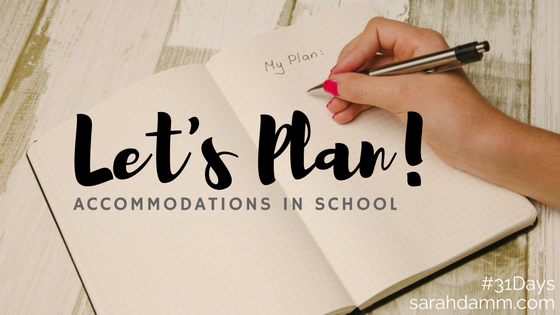
Day 24: #31 Days—Accommodations in School
When a child has Dyslexia, families find themselves immersed in a world filled with so much newness. Receiving a diagnosis, understanding what Dyslexia really is (and is not), finding a tutor, and comforting the roller coaster of emotions that the child might be experiencing can be quite a lot. It is overwhelming to figure it all out.
Then, there are the accommodations necessary within the school.
You see, what works for 80 percent of students does not work for the 20 percent with Dyslexia. Telling a family that “this is the way we teach reading” or “your child is going to have to catch up” can be frustrating and disheartening. Why are we teaching in a way that does not serve all of our students? Maybe it’s time for a renewal in education, giving teachers what they need to reach these bright, eager kids!
In the meantime though, an Individualized Educational Plan (IEP) or 504 is necessary to give students with Dyslexia access to the education they need.
I am not an expert at accommodations, but I am a mom who is navigating through this with her daughter. And I am happy to share what I have done and what seems to be working for our family.
Document. Before we even received a diagnosis, I started keeping a file of all correspondence I had with the school. This provides proper documentation of the proactive role I play in my child’s educational success. With this file, I am building a case to enlighten the school that she needs more help and empathy. So, for example, when I talk to the school about concerns, I express them in writing either via note or email and keep a copy for myself. It can be helpful to save notes about other aspects of education, too, such as positive performance, behavior, missed assignments, etc.
Keep a File. Create a three ringed binder to collect a sampling of your child’s work. It can include a variety of samples, such as art, spontaneous writing, math, and reading. You don’t need to save everything, just a sampling. Date them and keep them in chronological order. This demonstrates areas of strength, progress, and weakness.
Be proactive. At the very beginning of each school year, I reach out to my daughter’s teacher about her Dyslexia. I want a good relationship with her teachers, so that we can work as a team to give her the best access to her education. So far, her last three teachers have been wonderful to work with. They do not always know how to help her, but they have been open to dialogue and overflowing with compassion.
Ask for what your child needs. When working with the school on the accommodations your child needs in the classroom, be upfront. Decide what the top 3-5 accommodations your child needs the most. There might be more, but be specific about the most needed ones. Susan Barton has two Facebook videos that are really helpful. They are titled How to Prepare For School—Step 1 and Step 2. In addition, this is a very helpful handout when making a school accommodation plan.
Advocate. If things are not going well, be sure to share that with your child’s teacher and anyone in the administration who needs to know. The plan might not be perfect, but it can be tweaked along the way! Often, teachers do not know much about Dyslexia; they didn’t learn about it when they were training to be teachers. Unless they seek information on their own or have a resourceful parent on their side, it can be challenging for them to know how to help a child with Dyslexia. You just might be the missing link they need in really making a difference for the 20 percent!
For a complete list of topics and links, visit the landing page for 31 Days: One Mom’s Journey With Dyslexia or click the square image below.
